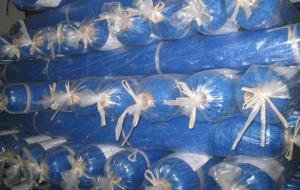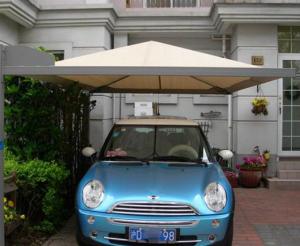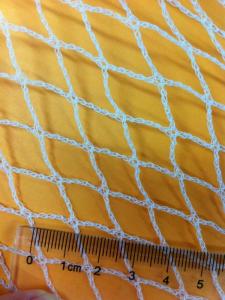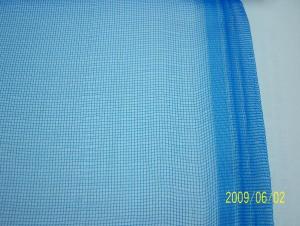Anti-insect Net-110g
- Loading Port:
- China Main Port
- Payment Terms:
- TT or L/C
- Min Order Qty:
- 2000kg m²
- Supply Capability:
- 5000t/month m²/month
OKorder Service Pledge
OKorder Financial Service
You Might Also Like
Anti-Insect Net
Introduction of Anti Insect net 110g :
It is weaved by High-density polyethylene (HDPE) UV stabilized mono filament, and is widely used in greenhouse construction.
Specifications of Anti Insect net 110g:
Material base fabric | Fabric Weight | Uv. Content | Temperature range |
HDPE | 80gsm up to 200gsm Standard Weight: 80gsm, 110gsm, 125gsm | 0.3% or 0.5% | -40 ~ +80oC |
Width: 1m, 1.5m, 2m, 3m, 4m, 5m, 6m (can be joined to 12m)
Length: 20m, 50m, 100m
Color: Clear, Black, Green, Blue
Minimum life length: 4 years, under normal weather conditions and use.
Using of Anti Insect Net 110g:
- Being an effective protection against insects like white fly, etc.
- Helping reduce the use of phytosanitary products against insects/plagues.
- Allowing maximum ventilation in hot seasons.
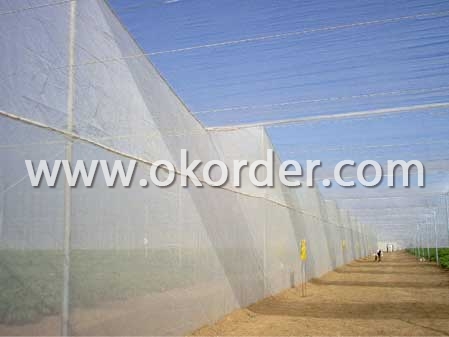
Packing of Anti Insect Net 110g:
in rolls on cardboard tubes & wrapped in plastic.

- Q: Are plastic nets resistant to chemical reactions?
- Plastic nets are generally resistant to chemical reactions, as they are made from materials such as polypropylene or polyethylene that have high chemical resistance. However, some chemicals can cause degradation or weakening of plastic nets over time, so it is essential to consider the specific chemicals involved and their compatibility with the material.
- Q: How do plastic nets provide support for vegetable gardens?
- Plastic nets provide support for vegetable gardens by acting as a trellis system, helping plants to grow upright and preventing them from sprawling on the ground. The nets can be stretched between stakes or poles to create a vertical framework, allowing plants like tomatoes, beans, peas, and cucumbers to climb and receive optimal sunlight and air circulation. This not only maximizes space but also helps prevent diseases, pests, and damage caused by contact with the soil.
- Q: Are plastic nets commonly used in the construction of basketball courts?
- No, plastic nets are not commonly used in the construction of basketball courts. Typically, metal or nylon nets are preferred for their durability and ability to withstand the outdoor elements.
- Q: Can plastic nets be used for creating shade structures in parks?
- Yes, plastic nets can be used for creating shade structures in parks. Plastic nets provide a lightweight and cost-effective solution for shading areas in parks. They are durable, easy to install, and can effectively block sunlight while allowing air circulation.
- Q: Can plastic nets be used for sports equipment?
- Yes, plastic nets can be used for sports equipment. Plastic nets are commonly used in various sports such as soccer, tennis, and badminton. They are lightweight, durable, and offer good visibility, making them suitable for sports equipment like goal nets, racket nets, and barrier nets.
- Q: Are plastic nets used in the manufacturing of bags?
- Yes, plastic nets are commonly used in the manufacturing of bags. They serve various purposes such as providing structural support, adding strength, and enhancing the aesthetic appeal of the bags.
- Q: How are plastic nets used in sports?
- Plastic nets are commonly used in sports to serve multiple purposes, such as containing balls within playing areas, creating boundaries, and providing a target for scoring goals or points. They are used in various sports including soccer, basketball, tennis, volleyball, and hockey, among others. These nets are durable, lightweight, and offer excellent visibility, allowing players and spectators to easily track the movement of the ball. Additionally, plastic nets are weather-resistant, making them suitable for outdoor sports as well.
- Q: Are plastic nets resistant to abrasion?
- Yes, plastic nets are generally resistant to abrasion.
- Q: Can plastic nets be used for animal enclosures in zoos?
- Yes, plastic nets can be used for animal enclosures in zoos. They are a cost-effective and durable alternative to traditional materials like metal or wood. Plastic nets provide good visibility for visitors while ensuring the safety and containment of animals. Additionally, they are resistant to corrosion, easy to clean, and provide adequate airflow for the animals.
- Q: How do plastic nets provide protection against insects?
- Plastic nets provide protection against insects by creating a physical barrier that prevents them from reaching and damaging plants or entering enclosed spaces. The fine mesh of the netting is designed to block the entry of insects while still allowing sunlight, air, and water to pass through, ensuring the plants' growth and productivity. Additionally, certain types of plastic nets can also act as a shield against larger pests like birds or rodents, further safeguarding the crops or enclosed areas.
1. Manufacturer Overview
| Location | Zhejiang, China |
| Year Established | 1992 |
| Annual Output Value | US$ 10 Million - US$ 50 Million |
| Main Markets | 50% CHINA , 50% OVERSEA |
| Company Certifications | GBT19001-2000 -ISO9001:2000 |
2. Manufacturer Certificates
| a) Certification Name | |
| Range | |
| Reference | |
| Validity Period |
3. Manufacturer Capability
| a) Trade Capacity | |
| Nearest Port | Ningbo ,China |
| Export Percentage | 50% |
| No.of Employees in Trade Department | 6 |
| Language Spoken: | English; Chinese |
| b) Factory Information | |
| Factory Size: | Above 100,000 square meters |
| No. of Production Lines | Above 10 |
| Contract Manufacturing | OEM Service Offered; Design Service Offered |
| Product Price Range | High; Average |
Send your message to us
Anti-insect Net-110g
- Loading Port:
- China Main Port
- Payment Terms:
- TT or L/C
- Min Order Qty:
- 2000kg m²
- Supply Capability:
- 5000t/month m²/month
OKorder Service Pledge
OKorder Financial Service
Similar products
Hot products
Hot Searches
Related keywords













